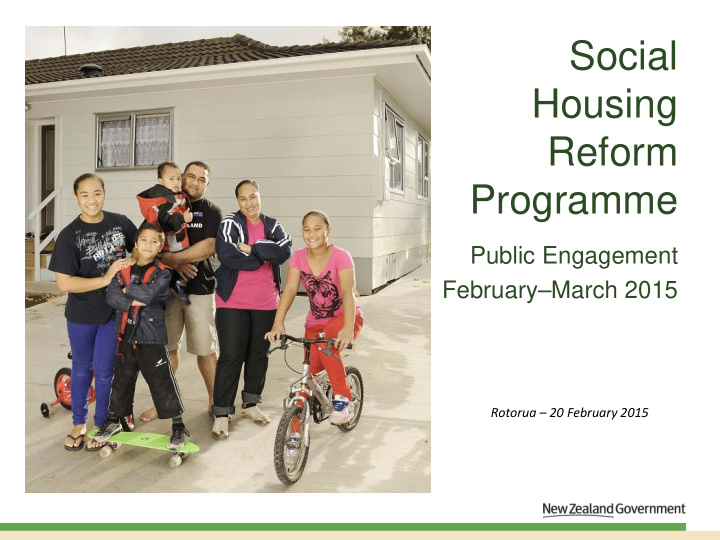



Social Housing Reform Programme Public Engagement February–March 2015 Rotorua – 20 February 2015
What today is about - Public engagement - We’ll discuss overall objectives, and describe the new social housing system, how you can participate, and next steps - April-May: Regional consultation on specific transactions - This is where we will be talking to you about your rights and interests 2
Social housing reforms – our objectives 1. Ensure people who need housing support can access it and receive social services that meet their needs. 2. Ensure that social housing is of the right size and configuration, and in the right areas, for those households which need it. 3. Help social housing tenants to independence, as appropriate. 4. Encourage and develop more diverse ownership of social housing, with more innovation and responsiveness to tenants and communities. 5. Help increase the supply of affordable housing, especially in Auckland. 3
Current situation – tenants - Around 62,000 social housing places funded through income-related rent subsidies ($209/week) - 6,000 social housing tenant placements/year - 5,000 on register for social housing - Two thirds are in Auckland - One quarter are currently in a social house, but want a transfer - Plus 290,000 accommodation supplements ($78/week) 4
Current situation – housing - Housing New Zealand owns 65,000 houses, and leases another 3,000 - 3,000 have tenants paying market rent - 2,300 are vacant (70% of which are unfit for use) - More than 1,000 Community Group Housing properties (don’t receive IRR) - Remainder receive IRR - 5,000 houses owned by Community Housing Providers - Currently 131 receive IRRS subsidies – and growing 5
How social housing providers are paid Tenant share is topped Tenants typically pay up to market rent by 25% of their income Ministry Landlords Registered community housing Ministry of Tenants providers, Social Housing NZ Development MSD contracts with community housing providers and Housing NZ 6
How to register as a community housing provider - Any social or affordable rental housing provider may apply for registration - An evaluation panel will assess applicants for eligibility, suitability and risk - Registered CHPs are eligible for income related rent subsidy - 38 CHPs already registered 7
Current situation – housing - Around one third of stock of Housing New Zealand is the wrong type… 8
Current situation – housing …or in the wrong place 9
How transactions will work Tenants Ministry of Social Development Offers MBIE Social housing regulator Registered community housing providers Business as usual sales Investors Housing NZ Treasury 10
Opportunities for community providers - 1,000-2,000 Housing New Zealand houses to be sold over the next year, with further sales if successful - Open to community housing providers and consortia including community housing providers - Competitive tender – we’re looking for best value - Opportunities for redevelopment – but must not reduce social housing supply - MSD will increase IRRS purchases to 65,000 by 2018 - We need 3,000 more houses in right place, right configuration - Looking for innovation, niche targeting in housing/wraparound services for better tenant outcomes. 11
Matters for iwi and hapū - The Government and Housing NZ are working to ensure your rights and interests are understood and managed appropriately - Where rights of first refusal apply, we will discuss this with you locally 12
Transaction types - Housing New Zealand business-as-usual sales (500 last year) - Social housing transactions through the Treasury (1,000- 2,000 over the next year) - Large one-off transactions e.g. Tamaki, Hobsonville 13
The approach on social-housing transactions - Selecting the first transactions - Areas where demand is stable, and housing providers are keen to expand or start up - Range of potential transaction sizes – from five to 600 depending on circumstances - Timing - Selection late March-early April, regional consultation in April- May - Information - We’re committed to full information disclosure 14
Next steps - February-March: public engagement on social housing transactions - Late March-early April: selection of specific transactions - April: Information release about MSD’s social housing purchasing intentions - April-May: regional consultation on specific transactions – this is where we talk to you about your rights and interests 15
Next steps - July: market sounding – testing regional interest - September: Expressions of interest Late 2015-mid 2016: request for proposals→preferred - bidders identified - November 2015: Cabinet review of progress and next steps announced 16
Our bottom lines – we will ensure… 1. There will be more social housing places in New Zealand - particularly in Auckland and Christchurch. 2. HNZC will continue to be by far the biggest owner of social housing in New Zealand and in a year's time it is envisaged that it will provide around 64,000 properties. 3. Properties will be sold only if this results in better services for tenants and fair and reasonable value for taxpayers. 4. Tenants in properties that are sold will continue to be housed for the duration of their need. 5. The government will spend more on IRRS and will ensure that HNZC has enough capital to build new social housing and to redevelop its existing properties. 17
If you are interested in getting involved… • For further information socialhousing.govt.nz • If you have any questions in the meantime, you can email info@socialhousing.govt.nz 18
Recommend
More recommend